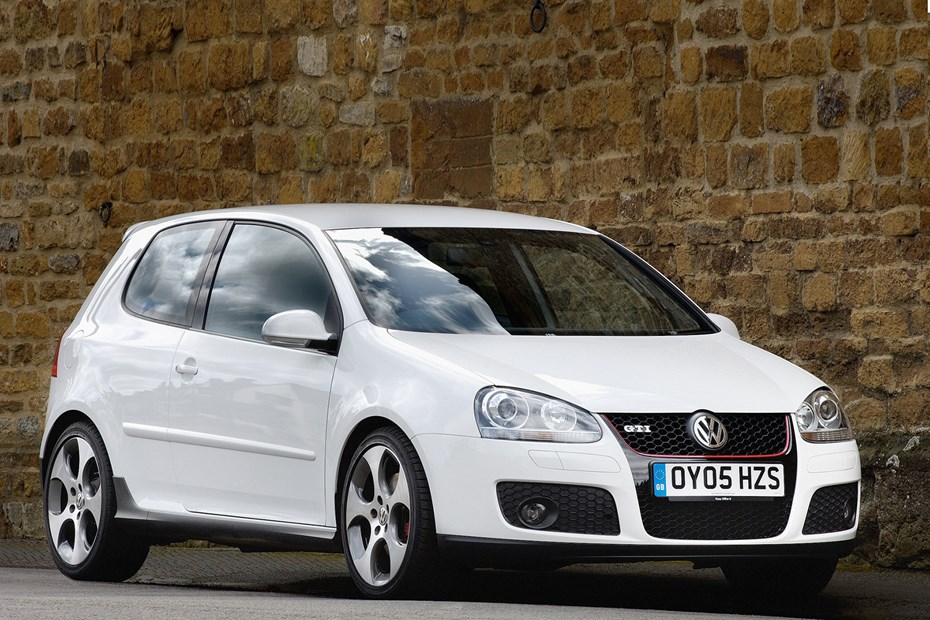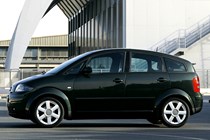Why buy any old used car when you can proudly put one of the best modern classics on your drive instead? They combine the best of both worlds – classic car collectability, desirability and the simple joy of ownership, coupled with modern car comfort, reliability and ease of use.
The best modern classic cars are also great investments. If you time it right, you can buy one for an affordable price and then sit back while it actually appreciates in value. Depreciation-free motoring and loads of smiles per mile – what’s not to like? So, the good news is that if you buy, say, a used luxury car for less than £10,000, the chances are it’ll become a modern classic before you know it, and you won’t suffer much in the way of depreciation.
But there are a number here that not so long ago would have been considered little more the some of the best used cars for less than £5,000, but time moves on, and sometimes what was once mudane is now seen as being interesting and cool. You’ll know when you see one in the list below.
Here, we’ve picked out 20 great modern classic cars, mainly from the 1990s and 2000s. All of them were noteworthy cars when new, whose reputation is simply growing as they mature. We’ve made sure they’re all affordable too, with all of these being picked up for between £2,000 and £20,000 – even the most expensive choices are, by the standards of their contemporaries, super-tempting purchases. Read on and be amazed at what great modern classics you can get for your money.
The best modern classic cars to buy
Editor’s choice: Volkswagen Golf GTI Mk5 (2005-2008)
Great to drive, strong image, and a bargain at current prices
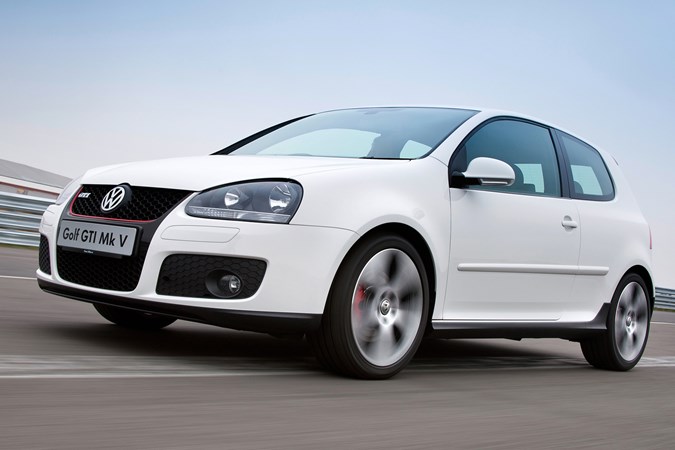
Pros:
✅ Around 200hp to play with
✅ Fun handling
✅ Great image
Cons:
❌ Avoid badly modified examples
❌ You pay a premium for better-looking three door
The Golf GTI was a hot hatch hit in the 1980s, but lost its way in the 1990s. The arrival of the marvellous Mk5 in 2005 brilliantly fixed the ills of the two previous versions. For starters, it celebrated its GTI heritage with plentiful bespoke styling features, from a full bodykit, to special dials, tartan upholstery and even the return of the famous golf ball gearknob.
With a 200hp 2.0-litre turbo engine, power was plentiful, and this super-smooth motor was matched by, at last, a genuinely entertaining chassis. Firm, focused and fun, this wonderful hot Golf revived the spirit of the famous Mk2 GTI, and then some. You can get them from less than £3,000 these days (ideally with evidence of a recent cam belt change), and they won’t stay this affordable forever.
Read our full Volkswagen Golf GTI Mk5 review
Peugeot RCZ (2009-2015)
Curiously interesting, excellent dynamics, and a cracking R version
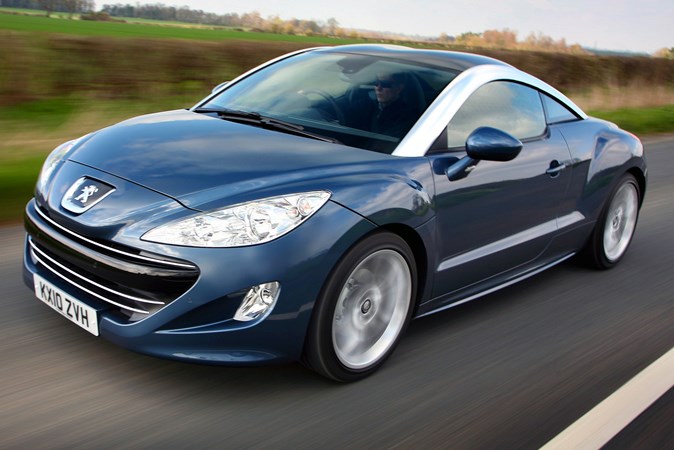
Pros:
✅ It’s rare and eye-catching
✅ Excellent handling and steering
✅ RCZ-R’s performance
Cons:
❌ Awful to work on
❌ Quality lags behind rival Audi TT
The Peugeot RCZ might be an unusual choice here, but this gorgeous and eyecatching French coupe ticks all the boxes for modern classic stardom. For a company with a back catalogue as dazzling as Peugeot’s, the RCZ arrived in the midst of a particularly dark period, injecting a dash of style and desirability while taking aim at the Audi TT.
As an ageing Peugeot, you need to have your wits about you. The RCZ suffers from a myriad of electrical issues, adds a dash of horrendous under-bonnet access, and completes the picture with poor parts availability to result in a car that the risk averse would do well to steer clear of. But there’s the 270hp RCZ-R range-topper, which is an absolute corker, with all the steering feel, acceleration and balance you’d ever want. Numbers are limited, so grab a good ‘un now, and reap the award for years to come.
Read our full Peugeot RCZ review
Porsche Boxster (1996-2004)
Now well-and-truly emerged from the shadow of the 911 as a modern classic in its own right
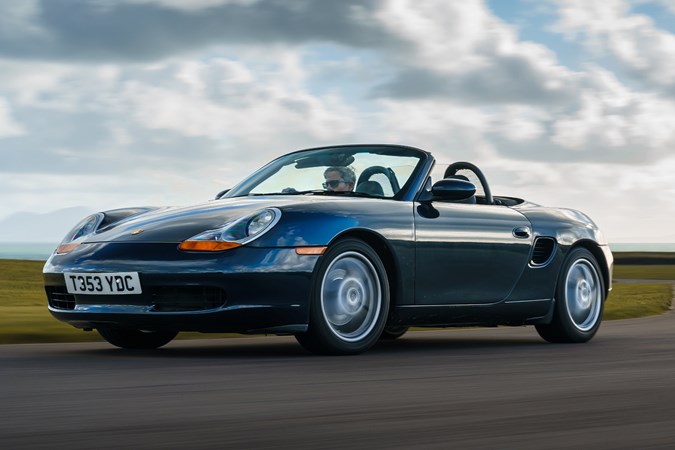
Pros:
✅ Fabulous steering
✅ Brilliant handling
✅ Boxster S has vivid acceleration
Cons:
❌ Servicing and parts are costly
❌ Standard Boxster isn’t particularly quick
We’d all like a Porsche 911. But even the cheapest are nudging £20k these days. So how about a Boxster instead? The front half and interior are basically from a 996-generation 911 anyway, and the mid-engined flat-six motors are just as charismatic. Acceleration is potent and the Boxster S is a genuine performance car, with perfectly balanced handling and oodles of feedback.
Best of all, instead of paying £20k for a well-used 911, you can get early 1996-on Boxsters from under £5,000. There are some well-known issues you need to be aware of, but experts are easily able to fix them these days – if the issues haven’t already been sorted. History tells us affordable Porsches don’t stay affordable forever, so now is the best time to buy a Boxster before its modern classic status starts to become more widely celebrated.
Read our full Porsche Boxster review
Mercedes-Benz CLS (2005-2010)
Coupe looks, saloon space, and some generally potent options
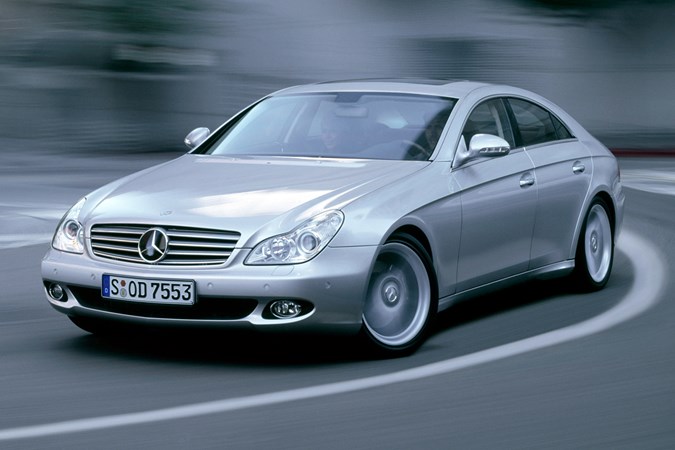
Pros:
✅ Genuine head-turning looks
✅ Quick versions are entertaining
✅ Diesels are excellent motorway cruisers
Cons:
❌ Forget entering a ULEZ in the CDI version
❌ Tight rear accommodation
A design icon in a world of chunky SUVs, the Mercedes-Benz CLS is rightly entering modern classic status. Launched in 2005, it was the world’s first modern four-door coupe, with achingly graceful and flowing lines. Mercedes-Benz also gave it a feel-good interior, featuring plenty of bespoke finishes – we love the wood-effect option.
It was derived from the period E-Class saloon, so drives in a very able and luxurious way. Refinement is superb and there’s a broad choice of engines: most were sold with a six-cylinder CDI turbodiesel. While it’s not as practical as an E-Class, interior space is still decent by coupe standards, and although there can be some reliability niggles, it’s broadly a car built to last. Choose from plentiful models on the used car market with prices for sound examples starting from £4,000.
Read our full Mercedes-Benz CLS review
Audi A2 (2000-2005)
It was the future once, and makes a huge deal of sense today

Pros:
✅ Supremely practical for such a small car
✅ All versions are economical
✅ Surprisingly fun to drive
Cons:
❌ Expensive to repair
❌ Almost all parts are bespoke to A2
The Audi A2 was is a great example of what happens when an engineering team gets on and builds its vision of a small family car without any input from the marketing boys and girls. So, it’s small, super light – thanks to aluminium construction – very aerodynamic, and an absolute delight to drive. But it’s also blessed with divisive looks, and proved costly for its maker to build. Hence its short production run.
But in these energy conscious times, the A2 really does make all sorts of sense. For one, it’s economical, with the diesel model capable of an easy 70mpg. Even the 1.6-litre 110hp petrol (which is a bit of a Q-car on the quiet) will crack 50mpg without breaking a sweat. But its small size and low weight results in a great steer – something Audi didn’t shine at back then. They are tough to work on though, and unlike many VW Group cars, it shares practically nothing with more humble models in the range, making a broken A2 potentially costly to fix.
Read our full Audi A2 review
Lotus Elise (1996-2000)
The Norfolk firm rediscovered its mojo by creating one of the best drivers’ cars of the decade
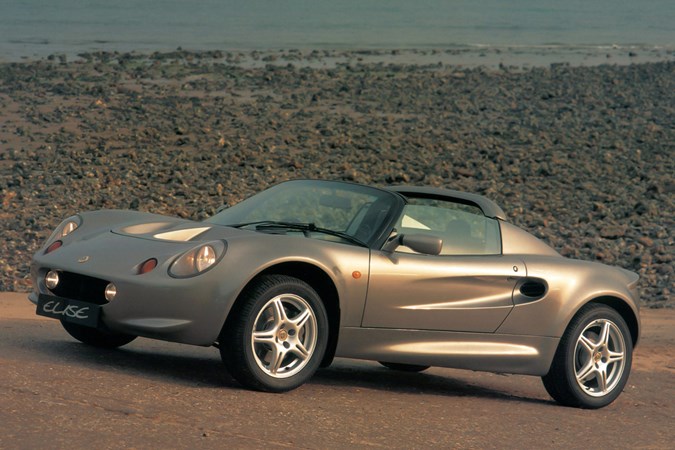
Pros:
✅ Level of responsiveness like no other car
✅ Lots of specialist support
✅ Modest running costs
Cons:
❌ Larger drivers might struggle to fit in it
❌ K-Series engine issues – although all are easily sorted
Modern Lotus is a company on the up. Get in on the act with a used example of perhaps the finest car it’s ever built – the divine Elise. A modern classic right from its launch in 1996, this simple, pretty, ultra-lightweight car is a driver’s dream. It’s one of the closest things you’ll get to a racing car for the road: it’s impossibly purist and a sensation overload.
Don’t expect many luxuries: it doesn’t even have carpets, and you’ll look in vain for air con. The manual roof is also extremely fiddly to operate. Instead, leave it off, and enjoy the sheer thrill of driving. Never has a simple 1.8-litre four-cylinder Rover K-Series engine given so much satisfaction – and you’ll love how simple and cheap it is to maintain, too. Even fuel bills are affordable. It’s easy to see why the Elise was such a game-changer.
Read our full Lotus Elise review
Mini Cooper S (R53) (2002-2006)
Quirky hot hatch with the added bonus of a supercharger
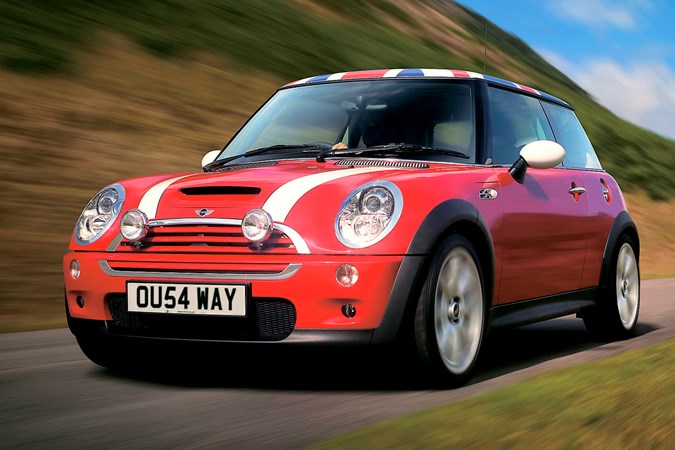
Pros:
✅ Pin-sharp steering
✅ Excellent roadholding
✅ Lots of specialist support
Cons:
❌ Build quality could be better
❌ Watch out for badly tuned-up examples
Rover and BMW brilliantly reinvented the Mini for the modern era with the 2001 revival. All of them today are well-established modern classics, and none more so than the exceptional Cooper S. It has an exciting 163hp 1.6-litre supercharged engine, delivering a charismatic whine under acceleration – it’s a bit like the noise an original Mini made, just turned up to 11. No original Mini ever accelerated this quickly in stock form, though.
The Cooper S has the same pin-sharp handling of a classic Mini too, but also some welcome modern-era luxuries such as a comfortable driving position and luxuries like air con, anti-lock brakes and electronic stability control. Spot a Cooper S at a glance from its bonnet vent and centre-exit exhausts – and then enjoy checking out the custom spec, because Mini offered myriad options when new. Remarkably, it’s yours these days from less than £2,000, and there are plenty of specialists who will help you keep it in tip-top condition.
Read our full MINI Cooper S review
Aston Martin V8 Vantage (2005-2018)
Suave looks, melodious engine and all the cool you’ll ever need
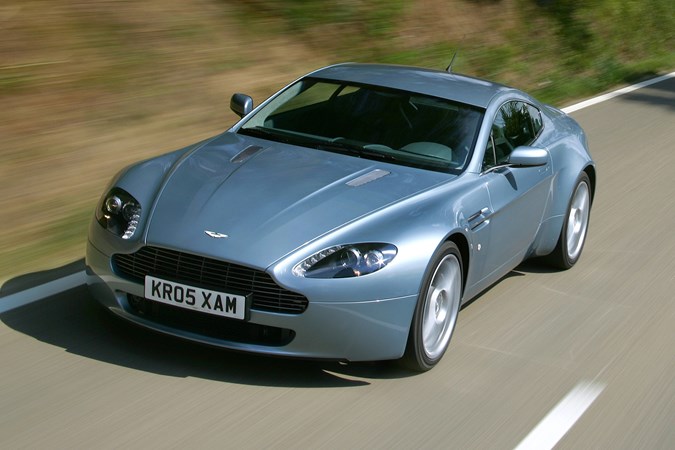
Pros:
✅ It’s an Aston Martin
✅ The potency of that V8 engine
✅ Looks to die for
Cons:
❌ Running costs aren’t in tune with modest purchase price
❌ Good, albeit pricey, specialist support
An Aston Martin is a dream car for many. And it’s a dream some can realise, with prices for the 2005-on V8 Vantage these days now well under £30,000. An Aston Martin or a new Polo GTI – what a fascinating choice to make! One of the firm’s prettiest modern-era cars, the hand-crafted Vantage still looks special, with its head-turning aluminium bodywork and jewel-like interior. It’s exciting to drive too, both in early 4.3-litre V8 guise, and the later, more powerful 4.7-litre.
The manual is best, as the automatics are a bit jerky. Make sure any potential purchase has been well looked after by an Aston specialist, and prepare yourself for much higher running costs than a conventional car. Be it heady insurance, sub-20mpg thirst or the eye-watering cost of servicing it, Aston Martin running costs are on another level. But choosing this modern classic will still be cheaper than a brand new one – and, besides, it’s still an Aston Martin, for the price of a new hot hatch.
Read our full Aston Martin Vantage review
Ford Fiesta ST Mk7 (2012-2017)
Quite simply the best small hot hatch of its generation
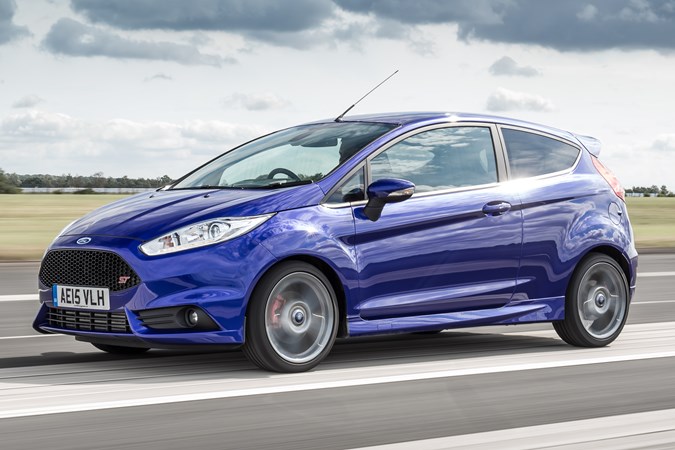
Pros:
✅ Quick acceleration
✅ Massive fun to drive
✅ Hot hatch practicality
Cons:
❌ It was – and is – a magnet for car thieves
❌ They don’t suffer from abuse well, so buy carefully
The Fiesta ST is the youngest car on our list, but it’s a surefire modern classic. Why? Because it’s a fast Ford, and as you all know, these are constantly in demand, end up being worth a fortune if in good nick, and have an almost fanatical following. But what really sets the Fiesta ST up for this list is that it is an absolutely fantastic car to drive, and represent great value from less than £8,000 for a well-equipped ST-2 with moderate miles on it.
There are plenty of models to choose from, so you can afford to be picky. Watch out for crash damage, evidence of bad tuning, and overall abuse. It’s easy to spot and generally not hard to find yourself a nice example without too much difficulty. They will get cheaper than they are now, but now really is the time to grab one while you can, and wrap it up in cotton wool for those high days and holidays.
Read our full Ford Fiesta ST review
BMW M3 (E46) (2001-2006)
The best M3 of the lot is also currently the cheapest. Not for long
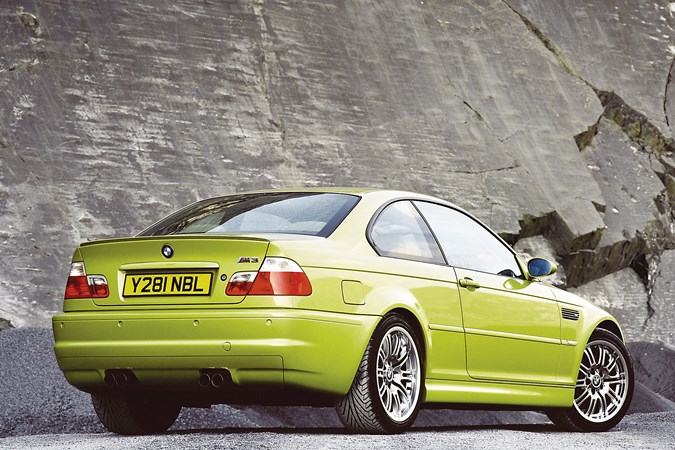
Pros:
✅ As good to drive as you’d imagine
✅ Six-cylinder engine is a belter
✅ Rear-drive handling is sublime
Cons:
❌ Savagely expensive repair costs
❌ V8 power for the GTR only
The classic E46 BMW M3 is widely acclaimed to be the best all-round M3 ever built. Sure, the original E30 is exciting, but it was also left-hand drive, highly specialist, and costs a small fortune these days (many are commanding six-figure prices). This six-cylinder M3 is a colossus, with Porsche-like performance, lithe and engaging handling, plus a real-world usability that the original 1980s car can never hope to match.
It’s also far more affordable, with prices these days from £15,000. Purists favour the manual but even the SMG isn’t as bad as internet forums would have you believe, and they are usefully cheaper. Cabrios cost less than coupes, too. But be warned – prices of all E46 M3 going up all the time, and it surely won’t be long before this M3 enters the genuine investor car arena. There will never be another M3 like this, so buy your modern classic now before it’s too expensive.
Read our full BMW M3 review
Jaguar XFR (2009-2015)
Not all super-saloons come from Germany. How about a 510hp Jaguar?
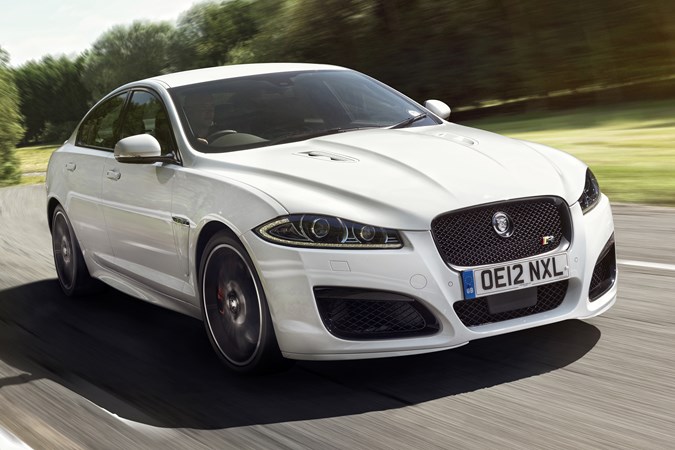
Pros:
✅ Rear-wheel drive excitement
✅ V8 soundtrack and all that entails
✅ Comfortable on the motorway
Cons:
❌ Can be a little lairy in the wet
❌ Expensive to tax, fuel and fix
Although some dyed-in-the-wool Jaguar traditionalists might disagree, the first-generation XF is probably the best saloon to wear a leaper badge. It’s sleek and progressive, roomy and powerful, and most importably for a Jaguar, it’s blessed with excellent reliability. The XFR takes the concept, and adds an additional dose of drama thanks to a supercharger, additional chassis development, and 510hp to play with.
This BMW M5 rivals is temptingly affordable these days, with perfectly usable examples available from £8,000, and excellent low-mileage examples coming in at less than £15,000. Of course, there are downsides – running and servicing costs can make you weep, while the build quality lags behind Audi and BMW. Having said that we can’t really fault its reliability, with a few electrical issues being its main Achilles’ Heel. Buy now, enjoy, and keep your eyes closed when filling it up…
Read our full Jaguar XFR review
Audi R8 (2007-2014)
The supercar that’s as easy to live with as your average family hatchback
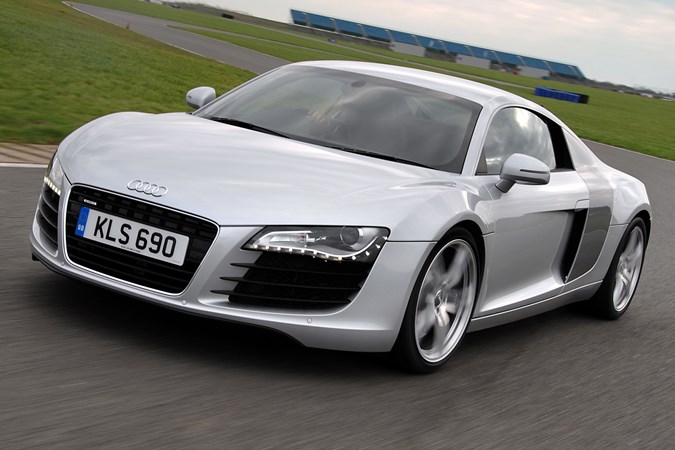
Pros:
✅ Supercar without the histrionics
✅ All models are exciting
✅ Four-wheel drive security
Cons:
❌ Minor damage can be massively expensive to fix
❌ Some reliability issues
The Audi R8 was the supercar that allowed even daily drivers to enjoy some exotica. Compared to contemporary Ferraris and Lamborghinis, it was far easier to live with, less intimidating to drive and, relatively, a fair bit cheaper to run. It was launched in 2007 with a wailing 4.2-litre V8, while a 5.2-litre V10 followed in 2009 with even more power and much more excitement.
Prices are, by modern classic supercar standards, extremely attractive – from £40,000 will get you into an early R8. Of course, it needs specialist servicing, and you’ll pay supercar rates of insurance, not to mention the fuel bills. But if you can stretch to it, there are few more accessible ways of getting into a slice of mid-engined, high-performance exotica. Just watch out for underside damage, aluminium chassis corrosion and leaking adaptive dampers.
Read our full Audi R8 review
Mazda MX-5 Mk3 (2005-2015)
In its third-generation, the MX-5 was as brilliant as ever…
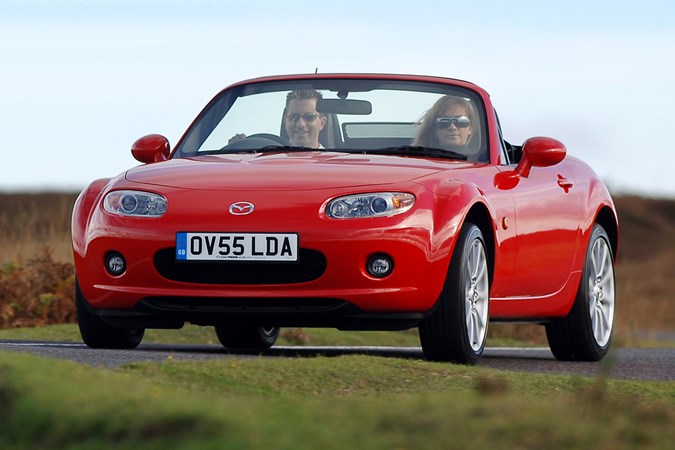
Pros:
✅ Stylish and great fun to drive
✅ Folding hard top option worthwhile
✅ Superb value for money
Cons:
❌ Can hide rust very well
❌ Not particularly economical
The Mazda MX-5 was a modern classic from the moment it was launched in 1990. It’s a brilliant buy as it’s ultra-reliable, easy and unintimidating to drive, and a genuine grin-a-minute delight for drivers of all abilities. It is, however, fair to say that rust is starting to make buying an original Mk1 or even a Mk2 a bit more of a challenge these days: so our tip is to go for the Mk3, sold between 2005 and 2015, and these days available for well under £5,000.
You still need to check for rust, of course – even these aren’t immune. But there’s less likelihood of it being terminal, and there are still plenty of well cared-for cars out there that remain pretty much immaculate. We like the 2.0-litre Sport, because it has 160hp power, a slick six-speed gearbox and a limited-slip differential for even more tenacious handling. But any MX-5 is a refreshingly purist joy to drive. As a dependable modern classic that should cost pennies to run and always be in demand when it’s time to sell it on, the bulletproof Mazda MX-5 has few rivals.
Read our full Mazda MX-5 review
What is a modern classic car?
This is a very interesting question and one that doesn’t have a definitive answer. If we lived in Germany, that would be easy – anything between 20- and 30-years old is known as a Youngtimer and as such gets recognition as a classic car. Like the UK, cars in Germany get classic car tax and legislative breaks when they hit a certain age – but unlike here, 30 years is the point it becomes officially recognised as ‘Historic’ (once a few checks on its condition have been made and it’s deemed to be in cherished condition), whereas here, it’s 40 years old.
Back to modern classics. Here in the UK, where that term Youngtimer doesn’t sit easily in the daily lexicon, we’re happy to say a car is a modern classic as long as it’s interesting, you can use it every day, it had merit when new, and has an enthusiast following. Some cars reach this point earlier than others, so a 10-year old Aston Martin Vantage is already a modern classic, whereas a base-level Kia Ceed in flat and faded blue, is going to take a little longer. That’s how it is, and there’s no getting away from that.
And remember, thanks to being able to register our cars as ‘Historic’ when they hit 40, regardless of what they are, they all become classic cars once the fourth decade has passed…
Are modern classic cars a good investment?
If you accept that we’re not here to offer investment advice, and that the prices of these cars can go down as well as up, then you can take it as read that these cars – bought well – are probably as near to depreciation proof as you can get right now.
That’s a different matter to being an investment, and on that, we’ll say that modern classics can be a great way of growing your money, but that should never be your prime motivation for buying one. So, all of these cars will go up in value, of that there is no doubt, but it’s just a case of how long will they take – because some will take a lot longer than others.
What car will be a future classic?
They’re all future classics. It’s just a case of how long do they take to go through their lifestages – from new to all-time classic – and how much interest there is in them.
What year is a modern classic car?
In reality, there’s no hard and fast rule about what is and what isn’t a modern classic car, and how it needs to be to become one. We’d tend to say that if there’s an owners’ club, and likeminded fans meet up to compare their cars at the weekend over a mug of tea and a bacon buttie, it’s a modern classic. Other fans may reel at some of these choices, but we’re all inclusive, right, and enthusiasm for interesting cars is there to be celebrated, yes?
Are classic cars better than modern cars?
In quantifiable terms absolutely not. Modern cars are faster, safer, better built and more reliable than ever before, leaving even the best classics trailing in their wake. But – and this is important – classic cars pull the emotional heartstrings, often making the driver feel special or taking them back to a different time. So, in that respect, if you treat them as more than mere conveyances, classic cars are certainly more interesting than their modern counterparts.
Want to comment?
Post your thoughts on the Parkers Facebook page
Keith Adams is the Editor of Parkers. During his career he has been the editor of Classic Car Weekly, Modern Classics and Honest John Classics, as well as writing for CAR magazine, Practical Classics, Octane, Autocar and The Independent among others. Keith lives in rural Lancashire and enjoys buying and selling cars and reading and writing about them.



